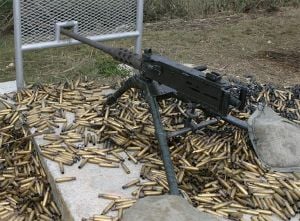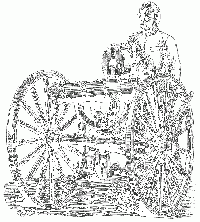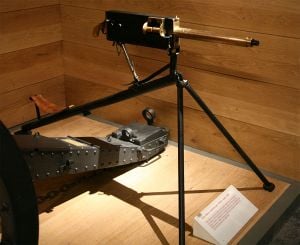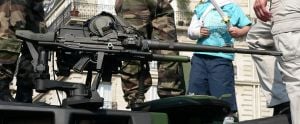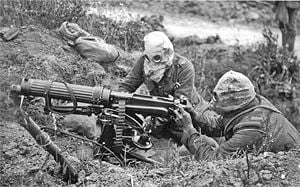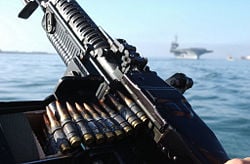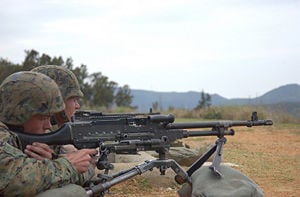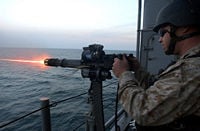Machine gun
A machine gun is a fully-automatic mounted or portable firearm, usually designed to fire rifle cartridges in quick succession from an ammunition belt or large-capacity magazine, typically at a rate of several hundred rounds per minute. Earlier machine guns were manually operated, for example, by turning a hand crank. According to United States law, a "machine gun" is a term of art for any fully automatic firearm (in United States law, a Machine Gun is defined in part by The National Firearms Act of 1934, as “… any weapon which shoots … automatically more than one shot, without manual reloading, by a single function of the trigger).
Machine gun technology developed to considerable sophistication in the late 19th century and early 20th century and was used with devastating effect by colonial powers against the native peoples, but the European military forces remained strongly locked into an earlier mindset about warfare in which the horse and the individual soldier were essential and valued elements in a military force. During World War I, however, the massive and impassive destructive power of the machine guns changed the equations of warfare, essentially eliminating the cavalry units and redefining the infantry units, which gained tremendously enhanced firepower through the addition of each machine gun unit. The machine gun's ability to blanket a battlefield with deadly bullets, permitting one team of two or four men to kill or maim hundreds marked a further step in the devaluation of human life.[1]
The creation and manufacture of machine guns in the latter part of the nineteenth century was undertaken in part with a goal of reducing warfare by making the cost of war too great.[2] Instead the effort became just one more step in the long-standing escalation of weaponry that culminated in the atomic and hydrogen bombs in the mid-twentieth century and is still on-going in other aspects of military technology.
History
Multi-shot weapons have a long history of development, going as far back as the first century, with plans for a multi-shot arrow gun by Greek engineer Hero of Alexandria. Leonardo Da Vinci devised plans for one in the 1400s.
The Chinese had some success with creating a repeating crossbow. The most common model, the Zhuge Nu (better known in the West as the Chu-ko-nu), is typically attributed to second- and third-century strategist Zhuge Liang, who developed it for the Kingdom of Shu during the Three Kingdoms period. However, a buried library in the ancient state of Chu indicates that some sort of repeating crossbow had at the very least been designed in the third century B.C.E.
Some weapons with machine gun-like traits appeared as early as the 1700s. However, it was not until the mid-nineteenth century that successful machine-gun designs came into existence. The key characteristics of modern machine guns—their relatively high rate of fire and automatic loading—came with the Model 1862 Gatling gun, which was adopted by the United States Navy. These weapons were still powered by hand. This situation, however, changed with Hiram Maxim's idea of harnessing recoil energy to power reloading in his Maxim machine gun. Dr. Gatling also experimented with electric-motor-powered models; this externally powered machine reloading has seen use in modern weapons as well. The Vandenburg and Miltrailleuse volley (organ) gun concepts have been revived partially in the early twenty first century in the form of electronically controlled, multibarreled volley guns.
It is important to note that what exactly constitutes a machine gun, whether volley guns are a type of machine gun, and to what extent some earlier types of devices are considered machine guns, are matters of debate. The answers can vary depending on which language and exact definition is used.
Early rapid-firing weapons
One of the first known ancestors of multi-shot weapons was created by James Puckle, a London lawyer, who patented what he called "The Puckle Gun" on May 15, 1718. It was a design for a 1 inch (in.) (25.4 mm) caliber, flintlock revolver cannon able to fire 9 rounds before reloading, intended for use on ships. According to Puckle, it was able to fire round bullets at Christians and square bullets at Turks. Although ahead of its time, foreshadowing the designs of revolvers, it was not adopted or produced.
In the early and mid-nineteenth century, a number of rapid-firing weapons appeared which offered multi-shot fire, and a number of semi-automatic weapons as well as volley guns. Volley guns (such as the Mitrailleuse) and double barreled pistols relied on duplicating all parts of the gun. Pepperbox pistols did away with needing multiple hammers but used multiple barrels. Revolvers further reduced this to only needing a pre-prepared magazine using the same barrel and ignitions. However, like the Puckle gun, they were still only semiautomatic.
The coffee-mill gun of the Civil War featured both automatic loading and single barrel, only separated functionally from the modern machine gun by being hand-powered rather than using cartridges.
The Gatling gun, patented in 1861 by Richard Jordan Gatling, was the first to offer controlled, sequential automatic fire with automatic loading. The design's key features were machine loading of prepared cartridges and a hand-operated crank for sequential high-speed firing. It first saw very limited action in the American Civil War and was subsequently improved. Many were sold to other armies in the late 1800s and continued to be used into the early 1900s, until they were gradually supplanted by Maxim guns. The Gatlings were the first widely used rapid-fire guns and, due to their multiple barrels, could offer more sustained fire than the first generation of air-cooled, recoil-operated machine guns. The weight, complexity, and resulting cost of the multibarrel design meant recoil-operated weapons, which could be made lighter and cheaper, would supplant them. It would be another 50 years before the concept was again used to allow extremely high rates of fire, such as in miniguns, and automatic aircraft cannons.
Maxim gun
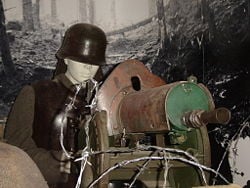
The first true machine gun was invented in 1881 by Hiram Maxim. The "Maxim gun" used the recoil power of the previously fired bullet to reload rather than being hand powered, enabling a much higher rate of fire than was possible using earlier designs. Maxim's other great innovation was the use of water cooling (via a water jacket around the barrel) to reduce overheating. Maxim's gun was widely adopted and derivative designs were used on all sides during the First World War. The design required less crew, was lighter, and more usable than earlier Gatling guns.
Heavy guns based on the Maxim, such as the Vickers machine gun, were joined by many other machine weapons, which mostly had their start in the early twentieth century. Submachine guns (for instance, the German MP18) as well as lighter machine guns (the Chauchat, for example) saw their first major use in World War I, along with heavy use of large-caliber machine guns. The biggest single cause of casualties in World War I was actually artillery, but combined with wire entanglements, machine guns earned a fearsome reputation. The automatic mechanisms of machine guns were applied to handguns, giving rise to automatic pistols (and eventually machine pistols) such as the Borchardt (1890s) and later submachine guns (such as the Beretta 1918). Machine guns were mounted in aircraft for the first time in World War I. Firing through a moving propeller was solved in a variety of ways, including the interrupter gear, metal reinforcement of the propeller, or simply avoiding the problem with wing-mounted guns or having a pusher propeller.
Interwar era and World War II
During the interwar years, many new designs were developed, such as the Browning M2 .50 caliber (12.7 mm) in 1933, which, along with others, were used in World War II. The trend toward automatic rifles, lighter machine guns, and more powerful submachine guns resulted in a wide variety of firearms that combined characteristics of an ordinary rifle and a machine guns. The Cei-Rigotti (1900s), Fedorov Avtomat (1910s), AVS-36 Simonov (1930s), MP44, M2 Carbine, AK-47, and AR-15 have come to be known as assault rifles (after the German term sturmgewehr). Many aircraft were equipped with machine cannons, and similar cannons (nicknamed "Pom-pom guns") were used as antiaircraft weapons. The designs of Bofors of Sweden were widely used by both sides and have greatly influenced similar weapons developed since then.
Germany developed during the interwar years the first widely-used and successful general-purpose machine gun, the Maschinengewehr 34, which inspired many modern machine gun developments. The later Maschinengewehr 42 was feared during WWII by Allied forces as it was capable of firing at a rate of 1200-1800 RPM with pauses of only a few seconds to replace the quick-change barrel when operated by experienced soldiers. The successor of the MG42, the MG3, is still today in use in the German army. Many modern machine guns are derived from the MG42.
Modern era
The Cold War era saw mostly a refinement of weapon types in the form of lower weight and higher reliability. The semi-automatic rifles of World War II vintage were almost totally replaced by lighter assault rifles such as the M16 and Soviet AK-47. Infantry adopted general-purpose machine guns like the American M60 for squad use, using air cooling for lighter weight. Heavy machine guns were retained for ground vehicles and fortifications. For aircraft use, even heavy machine guns proved to lack killing power in the air-to-air role, and by the late 1950s fighter aircraft armament had almost totally switched to automatic cannons. Machine guns, with lower recoil, remained popular for helicopters and for ground attack aircraft, supplemented by new Gatling-style, electric multibarrel weapons like the American Minigun. In police, special operations, and other paramilitary roles, smaller automatic weapons, including light submachine guns and machine pistols, proliferated, many relying on ubiquitous pistol rounds.
The last major use of a manual machine gun, was a manual grenade machine gun during the 1970s used on river boats in the Vietnam Conflict. The manual type, the Mk 18 Mod 0 was replaced by fully automatic ones such as the Mk 19 grenade launcher.
Types of machine guns
There are two main definitions of the upper limit of caliber for machine guns:
- caliber larger than 12.7 millimeter (mm) (.50 caliber)
- caliber larger than 20 mm
Larger-caliber automatic weapons are generally referred to as autocannons. In between, there are weapons that have been called by either name depending on other traits; for instance, there have been weapons of roughly 15 mm that were variably referred to as autocannons and machine guns.
Another factor is whether the weapon fires conventional rounds or explosive rounds. Automatic weapons firing large-caliber explosive rounds are generally either autocannons or automatic grenade launchers ("grenade machine guns"). Machine guns tend to share a very high ratio of barrel length to caliber (a long barrel for a small caliber).
There have been two main machine gun eras: The era of manual machine guns and the era of automatic machine guns. The technical development itself is marked by a series of developments of specific automatic features, as well as technical developments (such as linked ammunition). The era of manual multi-shot devices extends back hundreds of years (such as manual volley guns), but the development of manual and automatic machine guns takes place almost entirely in the latter half of the 1800s. Manual machine guns are manually-powered; for instance, a crank must be turned to power reloading and firing, as opposed to simply holding down a trigger, as with automatic machine guns. There are many other notable features, but this is one of the most significant, allowing the higher rates of fire common to machine guns.
Manual machine guns, as well as manual volley guns, saw their first major use in the American Civil War. The Gatling gun and "coffee gun" both used manually-powered automatic loading, fed via a hopper filled with cartridges. The Gatling gun—a manually-powered rotary machine gun—would be the major type of the late nineteenth century, though there were many other manual designs used to varying degrees (for instance, the Nordenfelt machine gun). The first automatic machine gun was the recoil-operated Maxim gun, which used linked (belt) ammunition, as well as a single barrel and automatic loading. This concept of using bullet energy would also drive the development of nearly all other semi and fully automatic firearms of the twentieth century.
The two major operation systems of modern automatic machine guns are gas operation (which uses the gas generated from the burning powder to cycle the action), or recoil operation (which uses the recoil generated from the ejecting bullet to cycle the action). The first gas-operated machine gun was the Colt-Browning M1895. Another (minor) type is the externally-powered machine gun. Rather than human manual power or bullet energy, a third source (such as an electric motor) is used; these types are now called by more specific names (see Minigun, Chaingun). The most common type of modern machine gun remains the automatic, recoil-operated, and belt-fed type. Electric and Gatling-type machine guns are common on combat aircraft and other vehicles.
Overview of modern automatic machine guns
Unlike semi-automatic firearms, which require one trigger pull per bullet fired, a machine gun is designed to fire rounds as long as the trigger is held down and ammunition is fed into the weapon. Although the term "machine gun" is often used by civilians to describe all fully automatic weapons, the military use of the term is restricted to relatively heavy weapons fired from some sort of support rather than hand-held, able to provide continuous or frequent bursts of automatic fire for as long as ammunition lasts. Machine guns are normally used against unprotected or lightly-protected personnel, or to provide suppressive fire.
Some machine guns have in practice maintained suppressive fire almost continuously for hours; other automatic weapons overheat after sometimes less than a minute of use. Because they become very hot, practically all machine guns fire from an open bolt, to permit air cooling from the breech between bursts. They also either have a barrel cooling system, or a removable barrels which allow a hot barrel to be replaced.
Although subdivided into "light," "medium," "heavy," or "general purpose," even the lightest machine guns tend to be substantially larger and heavier than other automatic weapons. Squad automatic weapons (SAWs) are a variation of light machine guns and only require one operator (sometimes with an assistant to carry ammunition). Medium and heavy machine guns are either mounted on a tripod or on a vehicle; when carried on foot, the machine gun and associated equipment (tripod, ammunition, spare barrels) require additional crew members.
The majority of machine guns are belt-fed, although some light machine guns are fed from drum or box magazines, and some vehicle-mounted machine guns are hopper-fed.
Other automatic weapons are subdivided into several categories based on the size of the bullet used, and whether the cartridge is fired from a positively locked closed bolt, or a non-positively locked open bolt. Fully automatic firearms using pistol-caliber ammunition are called machine pistols or submachine guns (largely on the basis of size); selective fire rifles firing a full-power rifle cartridge from a closed bolt are called automatic rifles, while those using a reduced-power rifle cartridge are called assault rifles.
Assault rifles are a compromise between the pistol caliber submachine gun and a traditional rifle firing a full-power cartridge, allowing semi-automatic, burst, and full-automatic fire options (selective fire). The modern legal definition of "assault rifle" is of significance in states like California, where according to state law, certain short, small-caliber, semi-automatic weapons are considered to be "assault weapons" and are thus illegal. Supporters of gun rights generally consider the use of the phrase "assault weapon" to be pejorative when used to describe these civilian firearms, and this term is seldom used outside of the United States in this context.
The machine gun's primary role in ground combat is to provide suppressive fire on the oposition's position, forcing the enemy to take cover and reducing the effectiveness of enemy fire. This either halts an enemy attack or allows friendly forces to attack enemy positions with less risk.
Light machine guns usually have simple iron sights. A common aiming system is to alternate solid ("ball") rounds and tracer ammunition rounds (usually one tracer round for every four ball rounds), so shooters can see the trajectory and "walk" the fire into the target, as well as direct the fire of other soldiers.
Many heavy machine guns, such as the Browning M2 .50 caliber machine gun, are accurate enough to engage targets at great distances. During the Vietnam War, Carlos Hathcock set the record for a long-distance shot at 7382 feet (2250 meters) with a .50 caliber heavy machine gun he had equipped with a telescopic sight. This led to the introduction of .50 caliber anti-material sniper rifles, such as the Barrett M82.
Components
All machine guns require the following components:
- A feed system to load the chamber. Cartridges can be fed into the chamber by a variety of methods, the most common being magazines or ammunition belts.
- A trigger mechanism to fire the round. This includes the actual trigger, a trigger sear to catch the bolt, a bolt and a firing pin, as well as other components. Typically, the act of pulling the trigger causes something to strike the primer on the round in the chamber and disengages the sears. This allows continual cycling of the bolt until the trigger is released. A sear then grabs the bolt or firing pins. This stops the machine gun at some point in its cycle.
- An extractor system to eject the spent or misfired cartridge. Usually this is fairly simple. A pin on the side of the bolt catches a ridge on the cartridge and flicks it out an ejection port.
These components form a mechanism which must be powered. If powered by absorbing the recoil of a cartridge, it is called recoil-operated. If powered by the expanding gases of a fired cartridge, it is called gas actuated. If powered by an external force, such as a motor, it is usually called a chain gun.
Operation
All machine guns follow a cycle:
- Removing the spent cartridge through an ejection port
- Cocking the trigger mechanism so the weapon can be fired again
- Loading the next round into the firing chamber. Usually spring tension or a cam forces the new round and bolt back into the firing chamber
A mechanism makes the firing pin fire the cartridge, activating the ejection and reloading steps. The cycle repeats. This full cycle takes a fraction of a second and can thus occur many times per second. The operation is basically the same, regardless of the means of activating these mechanisms. Some examples:
- Machine pistols and submachine guns (like the World War II "grease gun," MAC-10, or the Uzi) are usually blowback operated.
- Most assault rifles and squad automatic weapons are gas actuated. Some weapons, such as the AR-15/M16, integrate the piston with the bolt. Others, such as the AR18 and AK patterns, attach the piston to a bolt carrier that unlocks and operates the bolt.
- A recoil-actuated machine gun uses the recoil to first unlock and then operate the action. Heavy machine guns, such as the M2 .50 and Browning .50, are this type. These can be recognized by a large cocking lever needed to feed the first round.
- An externally actuated machine gun uses an external power source, such as an electric motor or even a hand crank to move its mechanism through the firing sequence. Most modern weapons of this type are called chain guns in reference to their driving mechanism. Gatling guns and revolver cannon have several barrels or chambers on a rotating carousel and a system of cams that load, cock, and fire each mechanism progressively as it rotates through the sequence. The continuous nature of the rotary action allows for an incredibly high cyclic rate of fire, often several thousand rounds per minute. Not all chain guns use multiple barrels or chambers, though. Chain guns are less prone to jamming than a gun operated by gas or recoil, as the external power source will eject misfired rounds with no further trouble. This is not possible if the force needed to eject the round comes from the round itself. Chain guns are generally used with large shells, 20 mm in diameter or more, though some, such as the M134 minigun, fire smaller cartridges. They offer benefits of reliability and firepower, though the weight and size of the power source and driving mechanism makes them impractical for use outside of a vehicle or aircraft mount.
Heavy machine guns are often water cooled or have interchangeable barrels, which must be changed periodically to avoid overheating. The higher the rate of fire, the more often barrels must be changed and allowed to cool. To minimize this, most air-cooled guns are fired only in short bursts or at a reduced rate of fire.
Not all machine guns strike the primer in the same way. In blowback machine guns, the act of seating the round also fires the round. In gas operated and recoil-operated guns, a separate step in the firing sequence is needed to strike the round. In a progressive-fire gun, the firing pin is cycled by cams. In some automatic cannon, the primer is fired electrically.
In weapons where the round seats and fires at the same time, mechanical timing is essential for operator safety, to prevent the round from firing before it is seated properly. This is especially important in weapons like the 40 mm grenade launcher, where high explosives are present in the rounds being fired.
Machine guns are controlled by one or more mechanical sears. When a sear is in place, it effectively stops the bolt at some point in its range of motion. Some sears stop the bolt when it is locked to the rear. Other sears stop the firing pin from going forward after the round is locked into the chamber.
Almost all weapons have a "safety" sear, which simply keeps the trigger from engaging.
Future development
Conventional machine-gun development has been slowed by the fact that existing machine-gun designs are adequate for most purposes, although significant developments are taking place with regard to anti-armor and antimissile weapons.
Electronically controlled machine guns with ultrahigh rates of fire, like Metal Storm's weapons may see use in some applications, although current small-caliber weapons of this type have found little use: They are too light for anti-vehicle use, but too heavy (especially with the need to carry a tactically useful amount of ammunition) for individual soldiers. The trend towards higher reliability and lower mass for a given power will likely continue. Another example, the six barreled, 4000 round per minute, XM214 minigun "six pack" developed by General Electric, has complex machinery, weighs 85 pounds, and has very little penetration power to show for it.
Human interface
The most common interface on machine guns is a pistol grip and trigger. On earlier manual machine guns, the most common type was a hand crank. On externally powered machine guns, such as miniguns, an electronic button or trigger on a joystick is commonly used. Lighter machine guns often have a butt stock attached, while mounted and tripod mounted machine guns usually have spade grips. In the late twentieth century, scopes and other complex optics became more common as opposed to just iron sights.
Loading systems in early manual machine guns were often from a hopper of loose (un-linked) cartridges. Manual volley guns usually had to be reloaded manually all at once (each barrel reloaded by hand). With hoppers, the rounds could often be added while the weapon was firing. This gradually changed to belt-fed types. Belts were either held in the open by the person, or in a bag or box. Some modern vehicle machine guns used linkless feed systems however.
Modern machine guns are usually mounted in one of four ways. The first is a bipod- often these are integrated with the weapon. This is common on light machine guns and also medium machine guns. Another major way is with a larger tripod, which can stand on its own. Medium and heavy usually use tripods. On ships and aircraft, machine guns are usually mounted on a pintle mount—essentially a steel post that is connected to the frame. Tripod and pintle mounts are usually used with spade grips. The last major way is disconnected from humans, as part of an armament system, such as a tank coaxial or part of an aircraft. These are usually electrically fired and have complex sighting systems.
Notes
- ↑ The Machine Gun Corps of 1914-1918.The Long, Long Trail: The British Army of 1914-1918 for family historians. Retrieved February 23, 2009.
- ↑ Ellis,John. 1986. The Social History of the Machine Gun. Baltimore, MD: The Johns Hopkins University Press. ISBN 0801833582
ReferencesISBN links support NWE through referral fees
- Gander, Terry. 2003. Machine Guns. Wiltshire, UK: The Crowood Press. ISBN 1861265808.
- Hogg, Ian V. 2002. Machine Guns: 14th Century to Present. Iola, WI: Krause Publications. ISBN 0873492889.
- Walter, John. 2006. Machine-Guns of Two World Wars. London, UK: Greenhill Books. ISBN 1853676063.
External links
All links retrieved November 5, 2022.
- How Machine Guns Work HowStuffWorks.
Credits
New World Encyclopedia writers and editors rewrote and completed the Wikipedia article in accordance with New World Encyclopedia standards. This article abides by terms of the Creative Commons CC-by-sa 3.0 License (CC-by-sa), which may be used and disseminated with proper attribution. Credit is due under the terms of this license that can reference both the New World Encyclopedia contributors and the selfless volunteer contributors of the Wikimedia Foundation. To cite this article click here for a list of acceptable citing formats.The history of earlier contributions by wikipedians is accessible to researchers here:
The history of this article since it was imported to New World Encyclopedia:
Note: Some restrictions may apply to use of individual images which are separately licensed.
